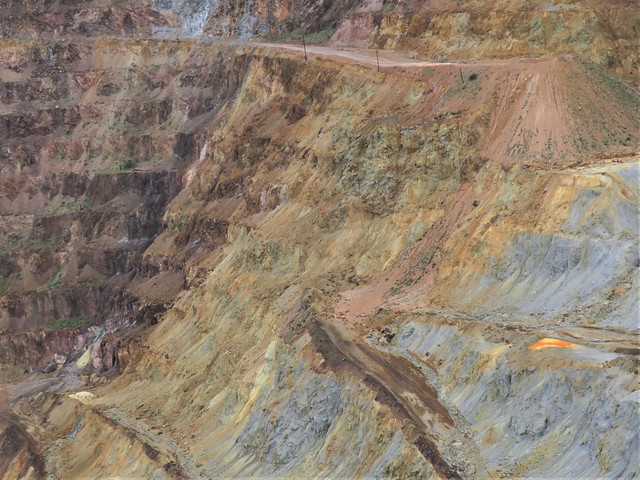 |
| Lavender Copper Pit, Bisbee, Arizona. August 2019. |
The colors and symmetrical planes of copper pits please my eye.
They gleam in hues of wet clay, spices, and semi-precious stones: Umber, saffron, cinnamon, caramel, amethyst. Ridged shelves rest on the mine's sloped sides like Andean terrace farms.
 |
| Lavender Copper Pit, Bisbee, Arizona. August 2019. |
But they are mines, and over my entire life, from middle school through this very moment, I have been messaged that mines are bad. Environmental destruction and contamination. Company stores. Black lung. Miners trapped in collapsed or flooded mine shafts. Draconian responses (often with the assistance of law enforcement and local, regional, and national government bodies) against workers who demand sustainable, equitable compensation and safe working conditions. Corruption. The lack of meaningful oversight for environmental and social justice by entities outside of the mining industry.
 |
| Lavender Copper Pit, Bisbee, Arizona. August 2019. |
Nevertheless, we want to pull from the Earth substances we can fold into our lives. People want employment, too, to feed, clothe, and shelter themselves and their families.
 |
| Lavender Copper Pit, Bisbee, Arizona. August 2019. |
Can we say that "fair trade" applies not only to us humans and our social communities, but also "fair trade" to the Earth - our water, soil, air, our brother-and-sister fauna and flora?
 |
| Lavender Copper Pit, Bisbee, Arizona. August 2019. |
Here is a video on the importance of copper mining in the state's history:
The closing credits of the video acknowledge the contributions of two copper mine companies, Arizona State University, and a miners' story project housed in the University of Arizona. It is a video that addresses only the rosy attributes of copper mining, like a 1950s propaganda newsreel in a movie theater. A pity, as such a one-dimensional presentation disrespects the viewers, the taxpayers, and the dignity of women, men, and children who live and work around mines.
Is there such a thing as ethical mining?
Maybe.
The International Council on Mining and Metals purports to be about responsible mining, about mining with principles, for a "safe, fair, and sustainable mining industry."
The Mining Association of Canada adopted written principles to:
- Engage with communities
- Drive world-leading environmental practices
- Commit to the safety and health of employees and surrounding communities
 |
| Lavender Copper Pit, Bisbee, Arizona. August 2019. |
The PEW Campaign for Responsible Mining (an "archived project" - circa 2009?) noted:
Mining of hardrock minerals—gold, uranium and other metals—on U.S. public lands is governed by the General Mining Law of 1872. Virtually unchanged since it was signed by President Ulysses S. Grant to promote development of the West, this frontier-era statute is no match for today’s modern mining. Under the 1872 law:
The Pew Campaign for Responsible Mining is a national effort to educate and encourage the public and policy makers to adopt a modern framework for mining in the West. Today:
- Mining companies—even those that are foreign-owned—are allowed to take approximately $1 billion annually in gold and other metals from public lands without payment of a royalty.
- There is scant regulation of the nation’s top-polluting industry and few resources to clean up abandoned mines. The Environmental Protection Agency has documented more than $2 billion in taxpayer spending over the past decade on mine cleanup.
- Mining is given priority status, on most public lands, making it nearly impossible to prohibit or restrict it, even near national parks and other iconic places, like the Grand Canyon.
- Taxpayers lose a conservatively estimated $100 million a year because, unlike with the coal, oil and gas industries, mining companies can extract valuable resources from public land essentially for free.
- Taxpayers face a multi-billion dollar mining cleanup bill. According to the Environmental Protection Agency, the mining industry releases more toxic pollution than any other.
- Federal agencies give hardrock mining on public lands priority status over other uses. It remains nearly impossible to restrict mining near national parks. Important water sources, wildlife and local communities are also vulnerable.
- The law allows claim holders to buy public land for $5 an acre or less, and to use it for anything from condominiums to casinos. Congress has temporarily halted the practice.
Worse yet, a new rush is on in the West. In recent years, mining claims for uranium, gold and other metals on public lands have increased dramatically. Many of these new claims lie near treasured national lands, as well as highly populated urban areas and tribal lands.
Proposed Rosemont Copper Mine Near Tucson
In August 2019, a US District Court delivered a ground-breaking decision related to the proposed Rosemont Copper mine in the Santa Rita Mountains by the Canadian company, Hudbay Minerals:
For decades, the U.S. Forest Service has said it can’t say “no” to a mine on its land.
Now, the recent federal court ruling overturning approval of the Rosemont Mine on service land near Tucson will make it harder for the Forest Service to say “yes.”
... The ruling could chill the hard-rock mining industry that has lived under a generally favorable legal climate since Congress passed the 1872 Mining Law to encourage mineral exploration of public lands. ....
Source: Tucson.com
A consortium of entities filed the motion against the Rosemont Copper mine.
Arizona Public Media attempted to explain some of the conflicts around the Rosemont Copper mine proposal in this May 2019 interview with a long-time, local journalist:
Related posts
Below, a slide show of my copper mine photos in Arizona, Texas, and New Mexico:

No comments:
Post a Comment